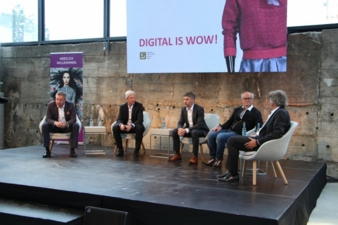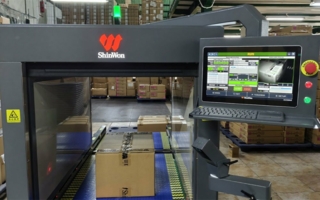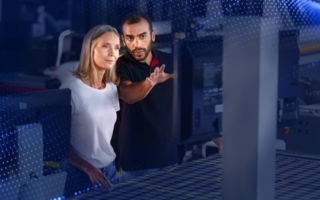15/08/2018 – Microfactory - part 8 — auf Deutsch lesen
Digitalization live – Fashion Forum 2018 with Microfactory Knit
Industry experts talked about the potential of the Microfactory in a panel discussion, while sweaters were knitted “live.”
A premiere at the Assyst Fashion Forum – for the first time, the Human Solutions Group company had its own Microfactory at its event, during which sweaters were knitted “live.”
A Stoll knitting machine was the “special guest”
A Stoll knitting machine was the “special guest” at the Assyst Fashion Forum. On both days of the event, the machine ran continuously, producing sweaters and fabric samples that the participants were able to design individually with Vidya. The possibilities offered by Microfactory production are exciting the entire industry – and all the panel participants agreed unanimously on this. Stoll also presented the knitting machines at the Adidas Pop-up Store “Knit for you” in Berlin in early 2017.
“A lot of people have asked us about this. The trend towards individualization is a driving factor, but the question of how to reduce time-to-market is also interesting the industry,” says Andreas Schellhammer, CEO of H. Stoll GmbH & Co. KG. “There’s a big upheaval in production about to hit us, and it will prove to be a challenge for machines, software and the entire process chain. However, it must be made clear that no company can do this on its own,” Schellhammer stressed. Partnerships are all-important.
A network of production units
Hans Peter Hiemer, b4b GmbH, spoke out in favor of a network of production units that will in future produce merchandise that is in close proximity to sales outlets and to the consumer above all. The trend is clearly moving in the direction of addressing a customer directly and integrate him or her into an individual design. Hiemer is sure of one thing, “Brands and retailers will have difficulties with their middleman function.”
Alexander Artschwager of the DITF Denkendor took a slightly different view – he continues to see brands as an important structure for consumers. “To me, Microfactories are regional production concepts that won’t be in a store.”
Business model wanted
The Microfactory on site proved that the technology is already here. But what will it take to disseminate the concept? “We have to inject creativity into the machine, algorithms are not (yet) able to develop designs and themes. The main task Microfactories face to become successful is to integrate the creative input of designers into digital processes without interfaces and to reward the performance of designers in a digital world,” says Artschwager. Andreas Seidl sees entrepreneurial courage and success models as prerequisites for the dissemination of the concept: “The technical hurdles are no longer as difficult. But all of us here are ‘system people’ – it will take someone to set up a consistent business model and show that it can be successful.”
Start-up mentality - just do it
Hans Peter Hiemer reminded the audience of the experiences with digitalization in other industries: “You now have young people without much business experience – but they have a completely new start-up mentality. “They’ve got the courage to empty their piggy banks and turn things upside down.” The industry experts were aware how difficult it is just to produce a simple white shirt, for instance. “A start-up today in this business doesn’t care how difficult it’s going to be! And it’s this attitude, this approach, that will be good for the industry.”
Eva Fröhlich, Iris Schlomski




